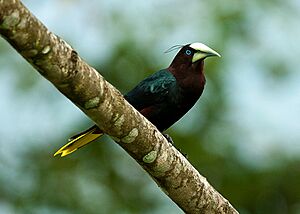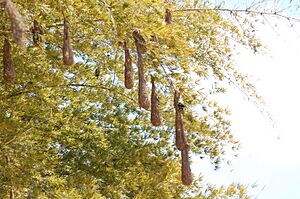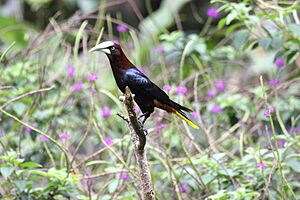Chestnut-headed oropendola facts for kids
Quick facts for kids Chestnut-headed oropendola |
|
|---|---|
 |
|
| At Cordillera de Talamanca, Costa Rica | |
| Conservation status | |
| Scientific classification | |
| Genus: |
Psarocolius
|
| Species: |
wagleri
|
 |
|
| Range of P. wagleri | |
| Synonyms | |
|
Psarocolius waglerii (lapsus) |
|
The chestnut-headed oropendola (Psarocolius wagleri) is a cool tropical bird found in the New World, which means the Americas. It's part of the icterid bird family, known for their bright colors and interesting songs. This bird's scientific name honors Johann Georg Wagler, who first described the group of birds called oropendolas.
Contents
Meet the Chestnut-Headed Oropendola
What Do They Look Like?
Male chestnut-headed oropendolas are about 35 cm (14 in) (14 inches) long. They weigh around 225 g (7.9 oz) (8 ounces). Females are smaller, about 28 cm (11 in) (11 inches) long and weighing 125 g (4.4 oz) (4.4 ounces). Both have very long wings.
Adult males are mostly black. They have a bright chestnut-colored head and lower back. Their tail is a vibrant yellow, except for two dark feathers in the middle. They have striking blue eyes and a long, whitish bill.
Females look similar to males but are smaller and their colors are a bit duller. Young birds are not as brightly colored as adults and have brown eyes.
What Do They Sound Like?
The male oropendola has a very unique song. It starts with a gurgling sound, like "guu-guu," and then ends with a loud, crashing noise, "PHRRRRTTT!" Both male and female birds also make loud "chek" and "chuk" calls.
Where Do They Live?
Their Tropical Home
The chestnut-headed oropendola lives in warm, tropical areas. You can find them along the Caribbean coast from southern Mexico down to central Costa Rica. They also live on both sides of southern Costa Rica and Panama. On the Pacific side, they are found in Colombia and northeastern Ecuador.
These birds usually live below 1,000 m (3,300 ft) (3,300 feet) above sea level. However, they have been seen as high as 1,300 m (4,300 ft) (4,300 feet). Scientists are still learning about their movements to higher places.
Their Habitat and Diet
Chestnut-headed oropendolas prefer to live in the tops of forest trees. They also like forest edges and old farms. They are quite common in many parts of their range. You can often spot them in small groups. They fly through the trees looking for food. Their diet includes large insects, fruit, and berries.
Family Life of the Oropendola
Building a Home Together
These birds are colonial breeders. This means many pairs build their nests close together in a group. They create amazing hanging woven nests. These nests are made from plant fibers and vines. They can be very long, from 60–100 cm (24–39 in) (2 to 3 feet) long! They hang high up in tall trees.

A colony can be quite large. There might be 40 to 50 female birds, but only about 4 or 5 males. The female lays two pale blue eggs that have dark marks on them. The eggs hatch in about 17 days. The young birds are ready to leave the nest after about 30 days.
Challenges for Young Birds
Young oropendola chicks face some challenges. One common problem is tiny fly larvae called Botflies. These larvae can cause problems for the chicks. Also, sometimes giant cowbirds (Molothrus oryzivorus) lay their eggs in oropendola nests. This is called brood parasitism. Interestingly, the young cowbirds that hatch in the oropendola nest will sometimes eat the botfly larvae, which can help the oropendola chicks!



